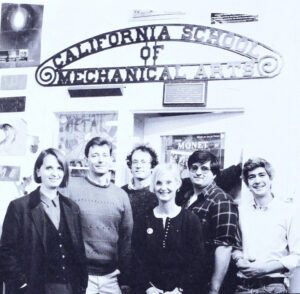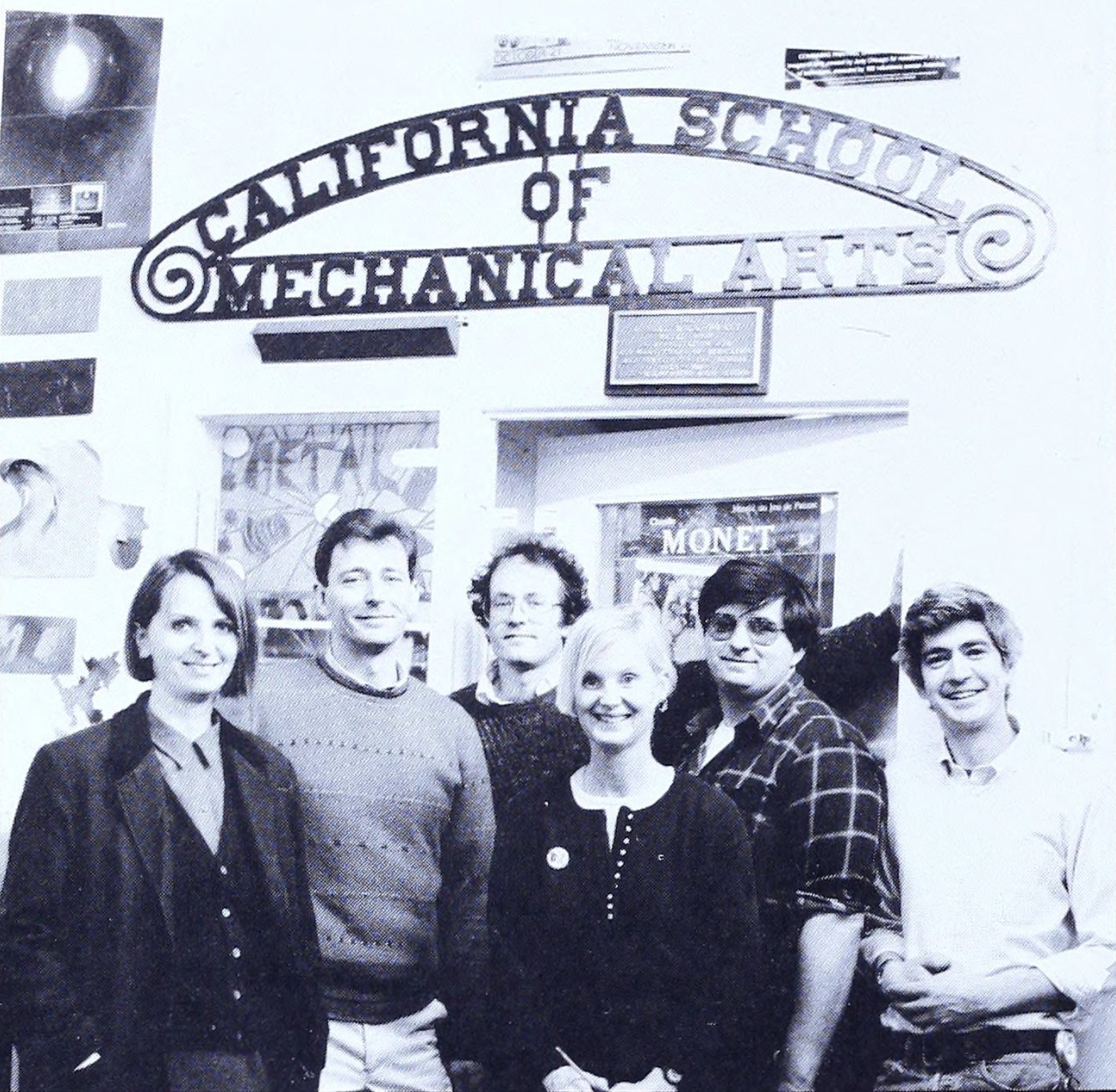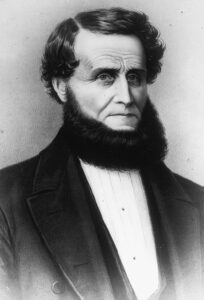The architecture program at Lick-Wilmerding is a significant draw for students, and a central focus for many student’s four years. It has been a longstanding unique asset to the school that continues to evolve.

Courtesy of the LWHS Archives
In 1874, James Lick established a trust to found the California School of Mechanical Arts for boys and girls. Just 20 years later, in 1894, Jellis Lute Wilmerding started the Wilmerding School of Industrial Arts. This all-boys school specialized in building trades and architectural drafting. Ever since the doors opened to LWHS in 1895, architecture has been essential to the school.
For the past 33 years, the architecture program has been run by Goranka Poljak-Hoy. Poljak-Hoy was an independently practicing architect before being hired by LWHS in 1989. After looking at job postings on an American Institute of Architects bullet-in board — “this was before Craigslist” — she went home and told her husband that “some school with an unusual name was looking for an architecture teacher.” After confirming her lack of teaching credentials was not a deal-breaker and assuring that she could speak English, she was offered the job.
Poljak-Hoy was born and raised in Yugoslavia and went to the University of Sarajevo where she studied and got a bachelor’s degree in architecture.
Originally, Polijak-Hoy thought she would teach for two to three years until architecture picked up for her outside of teaching, but after her fifth year, Poljak-Hoy said, “I was really starting to fall in love with it.” LWHS sent her to a teaching conference in Philadelphia during her fifth year called Experiential Pro where she met with teachers who had twenty-plus years of experience with teaching. Poljak-Hoy said, “Meeting those people and hearing their stories and enthusiasm and love for the field just got me energized.”
After returning from the conference, Polijak-Hoy talked to her husband about whether or not this was the time to return to architecture or continue teaching. He said, “You know, I haven’t seen you being this happy and I don’t think any building can give you that same kind of satisfaction as when you talk about your students.” So Polijak-Hoy stayed.
Before Poljak-Hoy, the architecture teacher was George Tyroglas, who was asked to leave when he refused to switch to computer-based architecture and learn DOS. Poljak-Hoy never met Tyroglas but inherited a golden scale tool with his name engraved on it, which was one of the few items left in the practically empty architecture studio classroom when she started.
When Poljak-Hoy started, the program had the basic elements of a drafting class and a studio room. Poljak-Hoy was asked to teach and design a curriculum for three courses: the “Drafting and Design” class, which was a legacy from LWHS’s early days, as well as traditional and computer-based architectural design.
Poljak-Hoy taught “Drafting and Design” until 2006 when the school adopted the course into the Design and Technology (D&T) class. After that, Poljak-Hoy then taught Contemporary Media and Art (CMA) as well as architecture. Poljak-Hoy said, “I think the program is extremely strong right now. It is always improving, and it just continues to improve.”
As soon as Pojak-Hoy started teaching, the school looked into how to get the approval for it — certification for UC credit. However, at that time, nobody was teaching architecture in high schools which made it difficult for the architecture and tech arts classes to get UC credit. It took at least 10 years before the architecture program was accredited by the UCs. Poljak-Hoy had to write, re-write and submit proposals until the architecture classes and eventually all the tech arts classes were finally approved.
During her first year, her classes were really challenging for students but Poljak-Hoy said, “I remember that they worked hard and I worked hard, they stayed after school, they came before school. I was at school at 7 and I never left before 5. The kids were always there working and trying to learn.”
Poljak-Hoy kept adapting her curriculum year after year by talking to her students and gathering feedback. Poljak-Hoy reflects that her second-year students, the class of ’94, were the most informative for her. Poljak-Hoy said, “There are a number of them who went into architecture, and even those who didn’t still keep in touch. They felt really nicely connected to me and to the curriculum at the time because they kind of built it with me.”
In the early 90s, Poljak-Hoy met a 93-year-old alum, Otto Hintermann, whose only training in architecture came from LWHS drafting and design. He never went to college or got a further degree in architecture, but spent his whole life working as an architect in Napa, California. At the time, people who had experience in drafting, or who were qualified as “draftsmen” could practice for 10 years and get an honorary architectural degree. Hintermann visited LWHS architecture students;Poljak-Hoy said, “It was amazing to see someone who’s almost a century old and remembers the school from the early 1900s.”
Before Autocad, when Pojak-Hoy started teaching, LWHS students used the online program, DOS, on PCs. The software required every command to be typed and it was extremely tedious just to connect two points with a line. Poljak-Hoy said, “That was terrible, I don’t know how anyone survived that.” Within five years, DOS was gone, and much more intuitive commands were introduced with the increasing availability of PCs and eventually Macs in 2006.
After 33 years of working at LWHS, Poljak-Hoy said, “My favorite part is the enthusiasm and optimism I get from my students. It is a really great source of inspiration and their neverending desire to grow and get better really makes me — especially in these hard times — think that things will still work out because my kids will be adults.” Many of Pojak-Hoys’ students continue to stay in touch both with her and the larger LWHS community.
“To the credit of the program, there are more than 100 practicing architects now who all were my students,” said Poljak-Hoy. “I lost count at 100, so I’m sure there’s more. It’s really great to know that some of them work with super famous architects. But then a lot of people are really happy doing their own work and being less famous, doing beautiful work for their own personal practices and slowly building their name and I think that’s quite amazing”
Aaron Lim ’02 was always interested in drawing and art and had never been exposed to architecture before coming to LWHS. Lim said, “I enjoyed the culture of it, going to Goranka’s classes and learning from her.” He fondly remembers looking at the many architecture books and magazines in the library as well as the treehouse project where students got to think about a more personal space and designed their own treehouse using Autocad.
After graduating from LWHS, Lim went on to study architecture at The Cooper Union in New York. After completing the five-year architecture program, Lim graduated with a Bachelor of Architecture degree.
Lim is now a sole proprietor and mainly designs single-family residential houses and small office spaces in San Francisco, as well as the wider Bay Area. Lim stays in touch with the LWHS community through some alumni gatherings along with the loose network of LWHS alumni who are a part of the architecture circle. Lim said, “Lick really prepared me to go to college and to study architecture. I think it was a really great introduction to the practice of architecture in terms of being rigorous about how you draw things and in that way I felt really well prepared.”
Lim said, “I really enjoyed just going to the studio and spending time working on our designs together with my classmates. It was a really social thing and so it just felt like a comfortable space to be creative and hang out with friends and learn about awesome design. That’s really stuck with me — the studio culture at Lick and that Goranka had set up and encouraged. She was super supportive of everyone.”
Another one of Goranka’s students, Tansy Mak ’07, enjoyed the change of pace of the architecture and design class. Mak said, “It was a unique challenge, compared to other academic classes, that was simultaneously very rewarding once you got to a successful idea or good design in your own eyes. I found that that continued to be the case throughout college and then also in the field of architecture.”
By her junior year at LWHS, Mak knew that she wanted to continue to pursue architecture and exclusively applied to colleges with five-year bachelor of architecture programs. Mak became a licensed architect 2 years after graduating from Cornell University. Mak now works in an adjacent field, working for a real estate developer as a design manager. Mak recently completed — start to finish — the Coterie Cathedral Hill, a senior resident building on the corner of Van Ness and O’Farrell.
Mak misses the cafeteria and her turkey pesto sandwiches on dutch crunch. She also misses, “On a more serious note, I would say Goranka, for sure. She was both a personal friend, mentor and obviously an amazing teacher. It is rare to find someone that giving and caring and I definitely miss her.”
Mak still keeps her LWHS experience close to heart. “This is a little cheesy, but the whole head heart and hands aspect of Lick’s mission and how important community and giving back is, still sticks with me now.” Mak is still involved with the program that led her to LWHS — Aim High — as a co-president of the Young Leader’s junior board. She said, “Aim High was the start of my journey to Lick and then architecture.”
Poljak-Hoy said,“I’ve met so many beautiful people — it’s endless. I think Lick draws beautiful people. I mean not physically beautiful, don’t get me wrong, but beautiful human beings who have big hearts. Maybe it’s because of head, heart and hands.”







